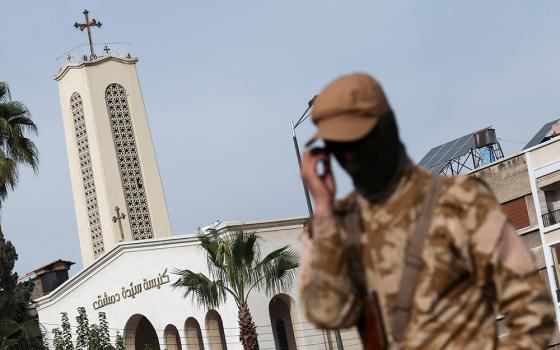
Religious life for the majority of U.S. sisters is at a crossroads. An aging membership and a decline in new vocations have communities probing what to do next to sustain their ministries and their way of life. These women sense a new era is emerging and they have decided to embark together on a new way of discerning that future.
When more than 600 sisters gather in Southern California Aug. 9-12 for the annual assembly of the Leadership Conference of Women Religious, they will set aside discussions on strategic planning and talks about mergers and consolidations. There won't be workshops on recruiting new members or on financing retirement. Gone will be the breakout sessions that often follow keynote addresses at their national meetings.
Instead, these leaders of the 334 congregations in the Leadership Conference will sit together in silence, discovering what God is calling forth for religious life today. They will have no expectation of a particular insight or result. Rather, they will spend time in collective contemplation to explore where religious life in the United States may be moving.
"We sense that something new is emerging," said St. Joseph Sr. Carol Zinn, a member of conference's executive committee, "but we certainly don't yet know what it will look like."
The sisters hope this contemplative process will "open us to a deeper place within ourselves" so "we can create with God the future God intends," said Marie McCarthy, a Sister of Providence of St. Mary of the Woods and a member of the Leadership Conference's Contemporary Religious Life Project, which is spearheading the five-year contemplation process.
It is an outgrowth of a call in August 2000 by the then-conference president, Immaculate Heart of Mary Sr. Nancy Sylvester, for women religious to enter into contemplation for "fostering the transformation of religious life."
In response, the conference has developed a process they've used at their regional meetings over the past year. But the assembly in Garden Grove, Calif., will be the first time all the leaders of the member congregations will engage in the process together.
A few religious communities, including the Providence Sisters and the Mercy Sisters, have adopted contemplative models for their chapter meetings and Leadership Conference officials see such contemplative discernment gaining momentum as the critical next step in the evolution of religious life.

"We are fewer. It's time to loosen our perceptions of who we are and listen attentively to what God is calling us to do now," she said.
Most congregations in the U.S. were established in the 19th century by small groups of women religious to serve the health and education needs of immigrants. They built the Catholic school system from elementary through college and established Catholic hospitals across the nation. Their communities grew as more women joined them in these apostolic works.
After Vatican II, their ministries broadened to address numerous other pastoral and social concerns. Today, sisters are lawyers and theologians, scientists and artists, spiritual directors and hospital chaplains, leaders of nonprofit organizations, advocates for immigrants, and outreach workers to the homeless and imprisoned.
However, with diminished personnel and more financial resources being dedicated to the care of frail, elderly members, the communities acknowledge that it is time to take a fresh look at who they are and what they are called to do.
"What's less clear today than in the past is where we need to go next," said Farrell.
What makes this moment so unique, she added, is that congregations recognize "it's time for us to try to find our way into the future together."
This solidarity among women religious, growing since the Leadership Conference of Women Religious began in 1957, has strengthened as congregations worked collaboratively over the past two-and-a-half years to respond to the Vatican's apostolic visitation of U.S. women religious communities.
Now they are probing their future together and in that process experiencing a resurgence of hope, said Most Precious Blood Sr. Mary Whited, a former conference president.
Collective contemplation
The contemplative process developed by the conference appears simple at first — reflect silently on global events of the past two years and how these events shape the mission of U.S. women religious, consider what new realities might be emerging and what responses to these realities are being called forth, then share those insights in a word or phrase with one another.
The depth of the experience, however, belies the apparent simplicity. It's a suspension of rational Western thinking as the participants drop into what Zinn calls "a contemplative way of seeing what God sees."
McCarthy added that the process allows "whatever wishes to emerge from within to do so."
What results, according to Whited, is a dialogue among participants that "goes far deeper instead of wider, embracing the breadth of movement of the Spirit."
McCarthy said this form of contemplation, though similar to Centering Prayer or mindfulness meditation, differs in two ways: It begins with a specific focus and ends with a sharing of insights.
"Sharing together from this place of depth without a programmed endpoint is part of the power of the experience. There is space left for us to notice the 'something new' that our God may be doing in our midst."
Just days after participating in the process during her community's chapter meeting, McCarthy enthusiastically attested to its power.
There was, she said, a new way of interacting, a kind of contemplative dialogue where the women were able to "hear one another in our differences" instead of getting caught up in the defense of opinions and ideas.
"We were able to re-look at everything so we can determine what needs to be repositioned for the sake of God's mission in the world."
For these Providence Sisters, that repositioning will include a realistic assessment of all their ministries in terms of financial sustainability and alignment with the congregation's core mission.
"If we have to let go to ministries or adjust lifestyles, we will do it," McCarthy said, because there is new clarity and renewed commitment flowing out of their contemplation together.
In a speech before the Sisters of St. Joseph in LaGrange, Ill., last October, author and spiritual director Judy Cannato said that a contemplative stance allows participants to be "free from the grip of fear and enter into a centered space that allows us to see with less anxiety and more clarity." (Cannato, an associate of the St. Joseph Sisters, died May 7 at age 62).
This contemplative process is not about self-evaluation or strategic planning, though both have important roles to play in decision-making, Whited said. Rather, it precedes and guides decisions by "going deeper to deal with what's underneath the realities and to look at the mystery."
She sees this contemplative process as the next step in the reexamination of religious life that began with the Second Vatican Council 40 years ago. "It is now time to stop and evaluate all the transformation that has happened since Vatican II and to determine what the Spirit is calling for now."
Model for the world
This contemplative process, the sisters assert, has potential far beyond religious communities. It can offer individuals, institutions and political entities a new way of resolving differences through collaboration and peace instead of competition and conflict. And it can help people stay in dialogue with one another in the midst of such differences so they can forge a new vision together.
"We have learned a great deal over the years about managing diversity and living together with polarities," Farrell said. That wisdom, coupled with a deepening access to the Divine, might very well be the unique gift women religious are about to offer the church and the world, she said.
McCarthy points out the growing interest in meditation across all sectors of American society and believes it's a sign of the times, one that garners great hope for the future of the entire planet. "This is not just a New Age fad, but a real experience of opening up to a new place," she said.
One manifestation of this shift is the increasing number of lay men and women who are affiliating with religious communities, not primarily as financial supporters but as integral partners in living out a community's spirituality and apostolic mission.
Called associates, affiliates or companions, they become imbued with a community's specific charism and explore with the sisters new ways of manifesting that spirituality within their own professions and personal lives.
These partnerships extend the sisters' ministerial reach, but also draw more and more laity into the communities' discernment process.
For example, when the Sisters of Mercy held their chapter at St. Xavier University in Chicago last month, along with the 120 official delegates, there were 120 non-elected participants. These included associates and companions as well as sisters. Both delegates and participants engaged simultaneously in the faith-sharing and discernment process.
It was a powerful example of a new form of collaboration and interdependence, said Sr. Joy Clough, a delegate and past president of the Mercy Sisters' Chicago Regional Community.
She added, "We don't know yet where religious life is heading in its practical form, but it will be there. How it will look and function in relation to the church and the world is the unknown."
Members of the Leadership Conference of Women Religious hope that through their contemplative process, a new Spirit-led vision will emerge.
[Monica Clark is an NCR West Coast correspondent. Her e-mail address is mclark@ncronline.org.]


